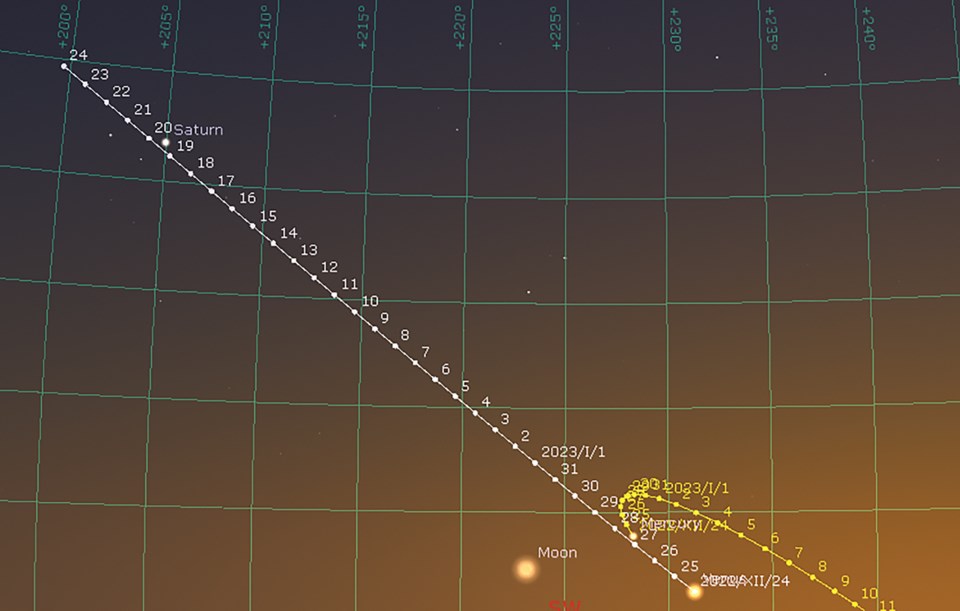The upcoming journalistic yearend means this article will be published a week earlier than usual; accordingly, some late events for 2022 make the grade.
First event is that two days after the winter solstice (Dec. 21 at 13:48), the new moon occurs at 02:17 on Dec. 23 – the publication date of this article. It’s like they knew, right? Coincidentally, the moon is at perigee Dec. 24, its distance 358,279 km., almost as close as it ever gets. The distance at perigee cycles roughly every six months with its lowest in December/January and again in July and with higher perigee values in between. I’m fairly sure this variation has to do with the orbital interactions between Earth, sun and moon, although there’s no way I’d attempt to prove it; the best before date on my math degree was long ago. Earth has an elliptical orbit around the sun with its perihelion (close) and aphelion (far) being Jan. 4 and July 6, respectively. Hence, the lunar cycle is almost perfectly aligned with the Earth’s orbital cycle and we’ll be at or near closest to both bodies right around Christmas Day.
As I mentioned in my December 2021 article, the tidal force on a body varies as the mass of the attracting body divided by the cube of its distance. If you look up all the mean values for Earth, sun and moon you find that the sun exerts a tidal force on the Earth of about 46 per cent of that of the moon. For the December new moon, however, when all three bodies align and are at their closest approach, the tidal forces are about 19 per cent greater than average. So, just like a year ago, we can expect extreme tides right after Christmas and exactly the same thing after the new moon on Jan. 21 – monster tides just like a year ago. As the late great Lawrence Peter (aka Yogi) Berra said, “It’s like déjà vu all over again.” And if the weather cooperates – no westerlies – then maybe no driftwood buffet on the Coast Highway by the Davis Bay pier.
Christmas Eve will also give us a picturesque alignment of a very thin crescent moon in the southwest evening twilight, about four degrees above the horizon. To its right about eight degrees and about the same elevation, will be a bright Venus and between them and slightly higher, Mercury. All three will set by about 17:00 that day but they may be visible in binoculars from about 16:15 on. Mercury is on its flyby in front of the sun; it passes about a degree above and right of Venus on Dec. 28 and 29 and we’ll lose it in the sun’s glare by yearend. Venus, however, just keeps moving up and left as it swings out from behind the sun. On Jan. 22, it passes less than half a degree below Saturn; the two will be easily visible in the same binocular field, less than the width of a full moon apart. The attached Stellarium screenshot show the paths of Venus (long and straight) and Mercury (short and curving) from Dec. 24 through Jan. 24.
Although winter weather on the Sunshine Coast isn’t exactly conducive to viewing meteor showers, we have a chance of seeing the Quadrantids for the peak time of the shower – Jan. 3 evening. The Quadrantid shower has a narrow peak – 12 hours or so – and the almost-full moon won’t help at all, so, like the Geminids, we probably won’t see the max ZHR (Zenithal Hourly Rate) of 120+/- per hour. According to Peter Jenniskens of the NASA Ames Research Center, the source of the Quadrantid meteors is debris from 2003 EH1, an “asteroid” that is probably a piece of a comet that broke apart some 500 years ago. The radiant of the shower is low in the north, just west of due north.
The January club meeting open to the public will be at the Sechelt Library at 7 p.m. Jan. 13, 2023. The presenter will be Dr. Christa Van Laerhoven, who will be doing a Zoom presentation entitled “Beyond Neptune,” a presentation about Pluto and other bodies out to the Kuiper Belt. She will be doing this from Whitehorse, Yukon, a location which is, thankfully for her, marginally warmer than Pluto. Any potential updates will be posted at the Sunshine Coast Club website at: https://sunshinecoastastronomy.wordpress.com/. We hope to see you there.



